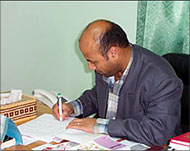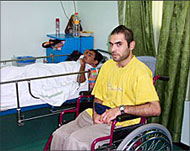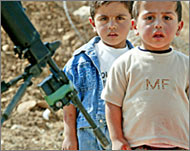Intifada takes physical and mental toll
As the Intifada enters its fourth year, scant attention has been given to the thousands of Palestinians who have been injured and handicapped for life.

Little notice has been given to the long-term physical, mental, and social health effects of this ravaging conflict, particularly on children and young adults.
An estimated 30,000 Palestinians have been injured during the second Intifada.
According to the Red Crescent, initial studies indicate that nearly 5000 of these have shifted from the category of injured to that of temporarily or permanently handicapped.
In al-Wafa Medical Rehabilitation Hospital, the only hospital in Gaza with in-patient services for the disabled and a meagre 50 beds, the scene is grim.
Some, such as Rifat Shaeir, 45, have no more future to speak of.
Rifat has been comatose since he was hit by a tank shell on his way to the Rafah middle school in the occupied Gaza Strip where he used to teach.
The tank shell took off half of his skull and a portion of his brain. He had left behind seven children and an unemployed wife.
“His family used to visit him every day, but now they hardly come once a week because of the costs of travel.
“For them, it comes down to deciding whether they want to use this money for visiting their father, or for buying food,” said Dr Khamis al-Essi, director of the hospital.
Others, like Abd al-Rahman Tayyam, 15, count themselves amongst the lucky.
 |
|
Dr Khamis al-Essi, al-Wafa Medical |
Tayyam had to have his leg amputated after being injured in a massive Israeli air attack against the Nusseirat refugee camp last month. The heads of the Israeli army later admitted to concealing the types of munitions used in the strike.
Ramzi Attaf, 20, took two 8mm bullets to the head in Rafah during the Israeli incursion of the camp in October, and is now wheelchair-bound and missing part of his skull.
Shooting to kill
According to al-Essi, 70% of the patients treated here are 15-29 years old, and more than 75% of the injuries are located in the upper part of the body.
“This demonstrates that the goal of the Israelis is not merely to disable but to kill. They are shooting with a purpose to kill,” he said.
Most of the patients that come in to the hospital suffer from severe spinal chord injuries and are now paraplegic. Al-Essi attributes this to the type of bullet being used, which shatters the target upon contact.
Huda Naem Darwish, 12, was shot in the head while sitting in her classroom in Rafah. A CT Scan revealed metallic fragments in her brain at the point of impact. Darwish suffered a severe brain injury and is now blind.
“During this Intifada, the types of disabilities are more varied and more severe,” said al-Essi.
“We have patients with multiple injuries… spinal and internal organ damage for example… so we face difficulties in classifying their injuries.”
Surviving the odds
According to al-Essi, al-Wafa was not operational in the last Intifada.
 |
|
Abd al-Rahman Rayyam (bed) and |
“Most patients were forced to stay at home, or if they were lucky enough to have a contact in the government, they could go to the West Bank for treatment. There was not a single hospital in Gaza to deal with the disabled.”
From the start of the Intifada until now, the hospital has managed to treat 206 Intifada victims in its inpatient clinic, and 188 others in its outpatient clinics.
Due to frequent closures between the northern and southern ends of the Gaza Strip, many patients in Rafah and Khan Yunis – areas most affected by the conflict – have been unable to receive the vital services they need.
As a result, the hospital has established two satellite clinics and two outreach programmes that work with the patients in their homes. Approximately 2270 patients have been treated in these clinics.
Psychosocial deterioration
In addition to the physically disabled, the Intifada has resulted in a vast number of psychosocial debilitations, according to Dr Taysir Diab, of the Gaza Community Mental Health Programme.
Diab says he has seen an increase in post-traumatic stress disorder, bed-wetting, anxiety disorders, depression, drug abuse, as well as domestic and physical violence.
|
About two in three children have seen a family member being injured or killed, 95% of children have witnessed funerals, and 83% have witnessed shootings |
“I believe the Intifada is leading to the deterioration in the psychosocial status of our people. I also think there are immeasurable long-term affects especially in terms of mental illnesses but also on the level of a new generation regarding their models of conflict resolution.”
“A lot of people have developed disorders [and] the behaviour of people in the street reflects this – people shout at each other for no reason and are easily provoked and there a general situation of stress,” said Diab.
He says children particularly have been affected.
According to a report published by Diab earlier this year, about two in three children have seen a family member being injured or killed, 95% of children have witnessed funerals, and 83% have witnessed shootings.
Such exposure to traumatic events, said Diab, had created an alarming increase in Post Traumatic Stress Disorder – or PTSD – symptoms in children. Some 82% of children interviewed for the study suffered from acute or moderate levels of PTSD.
Setbacks
Rabah Jabir, Director of the Palestinian Red Crescent Society’s Rehabilitation Department, said handicapped Palestinians in general – pre and post Intifada – had suffered serious setbacks because of the military occupation.
“More important than the injuries themselves is the negative impact the Intifada has had on the ability of the handicapped to get to rehabilitation centres,” said Jabir.
 |
|
Alarming increase of PTSD |
“A large number of patients, especially in the remote areas of Hebron and Nablus, are unable to get to rehabilitation centres in the cities because of the curfews, sieges, and checkpoints,” said Jabir.
Unlike its predecessor, this Intifada brought with it severe economic strain and suffering, he said. When it comes to deciding between food and treatment, physical rehabilitation was the clear loser.
“If they had to choose between paying 20 shekels [$4.5] for their son’s rehabilitation and using this money to buy bread, they will buy the bread,” said Jabir.
Regression
“[The handicap’s] situation should have evolved but it hasn’t. We have gone backwards. The negative social and mental consequences have multiplied. They end up staying at home and being isolated from family and society,” added Jabir.
In the end, the damage done to an entire generation of youth and to Palestinian society in general by the Israeli army will only truly become clear years from now, said al-Essi.
“In the past, we used to define disability in purely medical terms.
“But now we realise the long-term effects are not only on one person but on the whole society, especially since the overwhelming majority of the victims are under 29 years old and the rest are no older than 50.
“If these people are being incapacitated, the whole family will fall below the poverty line.”
“We don’t see these affects immediately. They will be visible years from now when we see hundreds of people walking on crutches or moving around in wheelchairs.”